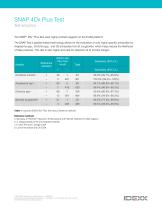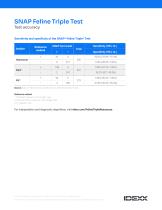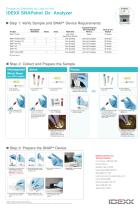
- Laboratory
- Laboratory medicine
- Rapid contamination test
- Idexx Laboratories

- Products
- Catalogs
- News & Trends
- Exhibitions
Veterinary rapid test SNAPcontaminationfor drugsfor milk

Add to favorites
Compare this product
Characteristics
- Application field
- veterinary, contamination
- Tested parameter
- for drugs
- Sample type
- for milk
- Format
- cassette
- Result display time
10 min
Description
Detects Tetracycline residues and is approved for use in the NCIMS Appendix N Pilot Program.
Tetracycline is one of the most commonly used antibiotics—make sure your milk is within residue limits.
How should I store my SNAP tests?
Please refer to your package insert for test-specific storage requirements. Refrigerate SNAP NBL Tests at 0–7°C (32–45°F). Refrigerate all other non-ST tests at 2–8°C (36–46°F). Tests can be kept at room temperature, 18–29°C (64–84°F), during the day of use. Remove only the number of tests to be used for the day.
Do SNAP tests need to be brought to room temperature before testing?
No, you do not need to warm the tests prior to use; you can run the SNAP tests directly out of the refrigerator. Do not open the foil pouch until you're ready to run the test.
Before you test:
Verify that the SNAP device has colored spots in the results window and activation circle.
Make sure the pellet is moving freely in the bottom of the sample tube.
Be sure your heater block has been preheated to a temperature within the 45°C ±5°C range.
Does the SNAP test need to remain on the heater block throughout the entire test?
Yes, the SNAP test must remain on the heater block at 45°C ±5°C for the duration of the test—during the incubation time, the activation time and the color-development time.
How critical is the activation time of the SNAP test?
Activation time is critical. After the initial incubation, pour the entire contents of the sample tube into the sample well of the SNAP device. Remain with the device and watch the sample flow across the results window toward the blue activation circle.
VIDEO
Related Searches
- Assay kit
- Blood assay kit
- Serum assay kit
- Immunoassay assay kit
- Infectious disease detection kit
- Blood rapid diagnostic test
- Immunoassay rapid diagnostic test
- Cassette rapid diagnostic test
- Virus rapid diagnostic test
- Serum rapid diagnostic test
- Plasma rapid diagnostic test
- Infectious disease rapid diagnostic test
- Whole blood rapid diagnostic test
- ELISA assay kit
- Clinical chemistry analyzer
- Automatic clinical chemistry analyzer
- Strip detection kit
- Benchtop clinical chemistry analyzer
- Bacteria rapid diagnostic test
- Animal assay kit
*Prices are pre-tax. They exclude delivery charges and customs duties and do not include additional charges for installation or activation options. Prices are indicative only and may vary by country, with changes to the cost of raw materials and exchange rates.



